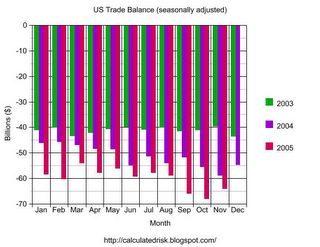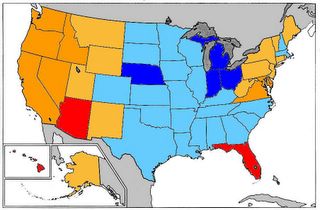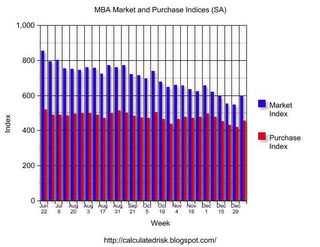by Calculated Risk on 1/12/2006 01:24:00 PM
Thursday, January 12, 2006
The Economist: Danger time for America
From The Economist cover story: Danger time for America
In [Greenspan's] final days of glory, it may therefore seem churlish to question his record. However, Mr Greenspan's departure could well mark a high point for America's economy, with a period of sluggish growth ahead. This is not so much because he is leaving, but because of what he is leaving behind: the biggest economic imbalances in American history ...
Handovers to a new Fed chairman are always tricky moments. They have often been followed by some sort of financial turmoil, such as the 1987 stockmarket crash, only two months after Mr Greenspan took over. This handover takes place with the economy in an unusually vulnerable state, thanks to its imbalances. ...
How should Mr Bernanke respond to falling house prices and a sharp economic slowdown when they come? While he is even more opposed than Mr Greenspan to the idea of restraining asset-price bubbles, he seems just as keen to slash interest rates when bubbles burst to prevent a downturn. He is likely to continue the current asymmetric policy of never raising interest rates to curb rising asset prices, but always cutting rates after prices fall. This is dangerous as it encourages excessive risk taking and allows the imbalances to grow ever larger, making the eventual correction even worse. If the imbalances are to unwind, America needs to accept a period in which domestic demand grows more slowly than output.
November U.S. Trade Deficit: $64.2 Billion
by Calculated Risk on 1/12/2006 12:14:00 AM
The U.S. Census Bureau and the U.S. Bureau of Economic Analysis reports that the U.S. trade deficit for November was $64.2 Billion. Imports fell slightly to a $173.5 billion from a record $175.5 billion in October.
Click on graph for larger image.
Imports from China were $22.4 Billion, down from a record of $24.4 Billion in October, while exports to China were steady at $3.9 Billion. Imports from Japan decreased to $11.9 billion from $12.2 Billion in October.
The Petroleum deficit was $22.9 billion, down from the October record of $23.9 Billion. The decrease in the petroleum deficit was primarily due to a drop in the price of crude oil.
Dr. Setser (US November trade data) and Kash comment on the trade data.
Wednesday, January 11, 2006
US Migration Patterns
by Calculated Risk on 1/11/2006 07:54:00 PM
United Van Lines released their annual analysis of US migration patterns: Southeast, West Continue to Attract Residents as Midwest, Northeast See More Leave
United classifies each state in one of three categories -- "high inbound" (55% or more of moves going into a state); "high outbound" (55% or more of moves coming out of a state); or "balanced." Although the majority of states were in the "balanced" category last year, several showed more substantial population shifts.
What stands out to me is that California is seeing a net outflow for the first time since 1995. And Florida is "balanced" after years of net inflow. This is probably related to housing prices in both states.
So lets compare migration to housing prices ... the following graph is house price appreciation based on the OFHEO House Price Index.

Click on graph for larger image.
Quarterly Appreciation:
Red: Greater than 20%
Dark Orange: 15% to 20%
Light Orange: 10% to 15%
Light Blue: 5% to 10%
Dark Blue: less than 5%
NOTE: D.C. is also red. These are annual rates of appreciation for Q4 2004 through Q3 2005. So this is not the exact same time period as the United analysis (calendar 2005). Q4 2005 is not yet available.
There are two regions seeing significant migration inflow: the West (excluding California) and the Southeast (excluding Florida). It is no surprise that western states like Arizona, Oregon, Nevada and Idaho have seen housing prices surge based on the migration data.
However, a similar pattern is not happening the Southeast. The states seeing inflows, like the Carolinas and Georgia, are not seeing above average house price increases. Perhaps there is more available land and higher rental vacancy rates.
Its no surprise that high outbound states like Michigan and Indiana are price laggards.
FED's Geithner: Monetary policy must account for Asset Prices
by Calculated Risk on 1/11/2006 05:41:00 PM
From Reuters: Fed must take asset prices into account on policy
U.S. monetary policy must take asset price fluctuations into account even if it cannot target them explicitly, New York Federal Reserve President Timothy Geithner said on Wednesday.Here is the text of Geithner' speech: Some Perspectives on U.S. Monetary Policy
The comments set Geithner apart from others at the central bank who had been quicker to dismiss the impact of significant price rises in assets like stocks or housing.
Some economists worry that, like the stock market in the late 1990s, housing prices may haven gotten out of whack with the fundamental value of home assets after a five-year boom.
While some of his colleagues have argued that there is simply nothing the Fed can do about it, Geithner said action was indeed warranted under certain circumstances.
"When policy-makers have already witnessed a significant move in asset values and are confident in what that move means for the outlook, it (the Fed) should be prepared to adjust policy accordingly," Geithner told an economics luncheon at the Harvard Club.
Geithner also reiterated his concerns over the longer-term stability of the global financial system, saying that the calm of recent years should not be taken as a green light for complacency.
He said the U.S. current account deficit, and the eventual need for an adjustment, posed serious risks.
"It would be hard for anyone looking at the size of the U.S. current account deficit to not be worried," Geithner said.
MBA: Mortgage Activity Rebounds
by Calculated Risk on 1/11/2006 12:14:00 PM
The Mortgage Bankers Association (MBA) reports: Mortgage Rates Down for Fifth Consecutive Week 
Click on graph for larger image.
The Market Composite Index — a measure of mortgage loan application volume was 600.1 -- an increase of 9.9 percent on a seasonally adjusted basis from 545.9 one week earlier. A holiday adjustment was included in the seasonally adjusted numbers to help account for the reduced application activity during the holiday week. On an unadjusted basis, the Index increased 27.2 percent compared with the previous week but was down 19.1 percent compared with the same week one year earlier.Rates on fixed rate mortgages decreased, while rates for ARMs were steady:
The seasonally-adjusted Purchase Index increased by 9.3 percent to 457.4 from 418.3 the previous week whereas the Refinance Index increased by 9.9 percent to 1497.5 from 1363.2 one week earlier.
The average contract interest rate for 30-year fixed-rate mortgages decreased to 6.08 percent from 6.15 percent on week earlier ...
The average contract interest rate for one-year ARMs increased to 5.42 percent from 5.41 percent one week earlier ...
Tuesday, January 10, 2006
China and the Dollar
by Calculated Risk on 1/10/2006 02:15:00 PM
It seems that every time there is a discussion of some foreign central bank diversifying away from the dollar, it is promptly denied by the rumored country. These two articles follow that pattern ...
From the WaPo: China Set To Reduce Exposure To Dollar
China has resolved to shift some of its foreign exchange reserves -- now in excess of $800 billion -- away from the U.S. dollar and into other world currencies in a move likely to push down the value of the greenback, a high-level state economist who advises the nation's economic policymakers said in an interview Monday.And from the AP: China's central bank denies dollar plans
As China's manufacturing industries flood the world with cheap goods, the Chinese central bank has invested roughly three-fourths of its growing foreign currency reserves in U.S. Treasury bills and other dollar-denominated assets. The new policy reflects China's fears that too much of its savings is tied up in the dollar, a currency widely expected to drop in value as the U.S. trade and fiscal deficits climb.
...
Some economists have long warned that if foreigners lose their appetite for American debt, the dollar would fall, interest rates would rise and the housing boom could burst, sending real estate prices lower.
The comments of the Chinese senior economist, made on the condition of anonymity because the government disciplines those who speak to the press without express authorization, confirmed an analysis in Monday's Shanghai Securities News stating that China is inclined to shift some its savings into other currencies such as the euro and the yen, or into major purchases of commodities such as oil for a long-discussed strategic energy reserve.
China said Tuesday it has no plans to sell dollars from its $800 billion-plus foreign reserves, rejecting speculation that had jolted financial markets and fed speculation about the possible impact on the U.S. dollar.
"We won't sell off our dollar-denominated assets," a central bank official, Tang Xu, told Dow Jones Newswires.
China's foreign currency regulator said last week its plans for 2006 include "widening the foreign exchange reserves investment scope." That sparked speculation that Beijing might shift some reserves from dollars, the bulk of its holdings, into other currencies.
...
Tang, director-general of the central bank's Research Bureau, said foreign reserves were expected to top $800 billion at the end of 2005, up from $769 billion when the last quarterly report was issued in September, according to Dow Jones.
ALSO: see Martin Feldstein's: Uncle Sam’s bonanza might not be all that it seems Note: Dr. Thoma provides excerpts: Martin Feldstein: Capital Inflows Primarily from Foreign Governments, not Private Investors
And Dr. Setser's comments: Martin Feldstein joins the dollar doomsday cult.
This is a key reason of why one of my top economic predictions of the year was that long rates would rise when the Fed starts cutting rates later this year.
Monday, January 09, 2006
The End of Defined Benefit Plans
by Calculated Risk on 1/09/2006 02:06:00 AM
First, my post on Angry Bear, Stiglitz and Bilmes: The Real Cost of Iraq War
The NY Times reports: More Companies Ending Promises for Retirement
The death knell for the traditional company pension has been tolling for some time now. Companies in ailing industries like steel, airlines and auto parts have thrown themselves into bankruptcy and turned over their ruined pension plans to the federal government.This will put the burden on the employee and from my experience, the employees that will probably need the benefits the most, will contribute the least (as a percentage of income), and invest poorly.
Now, with the recent announcements of pension freezes by some of the cream of corporate America - Verizon, Lockheed Martin, Motorola and, just last week, I.B.M. - the bell is tolling even louder. Even strong, stable companies with the means to operate a pension plan are facing longer worker lifespans, looming regulatory and accounting changes and, most important, heightened global competition. Some are deciding they either cannot, or will not, keep making the decades-long promises that a pension plan involves.
...the pension freeze is the latest sign that today's workers are, to a much greater extent, on their own. Companies now emphasize 401(k) plans, which leave workers responsible for ensuring that they have adequate funds for retirement and expose them to the vagaries of the financial markets.
When I was a trustee for a 401(k) plan, I saw the following behavior repeated many times: Less sophisticated investors would tend to be overly conservative putting most of their money in money market funds. Then they would occasionally invest in whatever went up in the most recent quarters. If they had a losing quarter, they would scurry back to the money market fund. Their overall results were poor.
This will leave Social Security Insurance as the only defined benefit portion of an individual's retirement income - an insurance policy for life's vagaries.
Friday, January 06, 2006
What will the Fed do?
by Calculated Risk on 1/06/2006 08:19:00 PM
Here is another Fed Watch from Dr. Duy: A Little Something for Everyone. Duy mostly looks at the employment report, but he also writes:
Wall Street's stamp of approval implies a wide expectation of "one and done" for this tightening cycle. That's not quite my interpretation, although I can't blame traders for looking for good news after a dreary December. Instead, I left the minutes with the sense that another rate hike at the end of the month is in the bag, but beyond that, future changes in policy are not automatic but instead data dependent. That is decidedly not the same thing as "done."Barring some drastic change in the data, I think two more rate hikes are "in the bag" and we will see 4.75% at the March meeting.
As a note: Dr. Duy's Fed Watch is a regular column on Economist's View. For weekly updates on market expectations for the Fed Funds rate, see Dr. Altig's Macroblog.
The reason I think the Fed will raise rates at least two more times is because: 1)the data will probably be inconclusive and 2) Dr. Bernanke has been heavily criticized (I think unfairly) for being an inflation dove based on this speech: Deflation: Making Sure "It" Doesn't Happen Here and, therefore, if the Fed pauses at Bernanke's first meeting in March that would inflame the criticism. So I believe Bernanke will lean towards one more hike to prove his inflation fighting credentials.

Click on graph for larger image.
Using the Cleveland Fed Median CPI, this graph shows the real Fed Funds rate by quarter for the last five years - the period of emergency interest rates.
I think the Fed would like to see inflation below 2% - median CPI was 2.6% annualized last month and 2.4% over the last 12 months. To achieve their goal, the Fed will probably have to raise the real Fed rate to 2% to 2.5% and that puts the nominal Fed Funds rate at 4.75% or even 5%.
After the January hike, the key data will be the various measures of inflation. If inflation is subsiding, then the Fed might stop. If its close, I expect another hike in March.
When will the Fed cut rates?
I've written several times that I expect a rate cut later this year. The reason I expect a cut is because of the impact of a housing slowdown. If there is no housing slowdown, as predicted by Wells Fargo, then I doubt we will see a rate cut in 2006. If there is a slowdown, I expect two things: 1) Mortgage equity withdrawal to decrease significantly and impact consumer spending (like what happened in England) and 2) housing related employment to fall.
The Fed doesn't like to change directions too quickly. Looking at the Fed's recent history:
Rates peaked at 6.5% on May 16, 2000 and the first rate cut was almost 9 months later, in January 2001.And speaking of England, the Bank of England repo rate peaked in August 2004 at 4.75% and the BOE cut the rate to 4.5% one year later.
Rates peaked at 6% on Feb 1, 1995 and the first cut was 5 months later in July.
So, if housing slows down, I expect a rate cut in late 2006.
Wells Fargo forecasts 6.5% 2006 SoCal House Appreciation
by Calculated Risk on 1/06/2006 04:43:00 PM
Wells Fargo is forecasting 6.5% house price appreciation in Southern California for 2006 compared to their estimate of 14.3% in 2005.
An internal forecast from a Wells Fargo Senior Economist:
| Wells Fargo Forecast | 2005(est) | 2006(f) |
| Median Existing Home Price | $489K | $521K |
| Percent Change in Prices | 14.3% | 6.5% |
| Housing Starts | 101.3K | 103.4K |
| Single Family Starts | 72.4K | 74.3K |
| Multifamily Starts | 28.8K | 29.K |
Christopher Thornberg, senior economist with the UCLA Forecast, expects housing construction to drop by 25 percent next year, resulting in significant job loss for the construction industry.Two very different views.
Employment Report
by Calculated Risk on 1/06/2006 02:37:00 PM
The BLS reported:
"Total nonfarm payroll employment increased by 108,000 in December, and the unemployment rate was little changed at 4.9 percent"Kash calls the report "disappointing" and pgl looks at the labor force participation rate and the employment-population ratio.

Click on graph for larger image.
Although the December report might be disappointing, the number of jobs created in 2005 seems solid.
A major concern going forward is the impact of a housing slowdown. Housing was once again a key driver for employment gains in 2005; construction alone added almost 250K jobs. Since construction usually accounts for around 5% of total employment, I would have expected around 100K construction jobs given the total employment growth.
The good news is the economy has been adding jobs at around the expected rate. The bad news is the economy is probably still too "housing centric".


